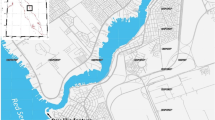Abstract
The two-dimensional shallow-water equations are developed for non-orthogonal curvilinear co-ordinates, in terms of the local deviations of the mesh from east and north. The equations are discretised and applied to a numerical model of tides in the Menai Strait in north Wales. The mesh is designed partially to fit the coastline and deep channels in the domain. After calibration, the model produces results which correspond well with measurements.











Similar content being viewed by others
References
Borthwick AGL, Akponasa GA (1997) Reservoir flow prediction by contravariant shallow water equations. J Hydraul Eng 123:432–439
Burchard H, Bolding K (2002) GETM: a General Estuarine Transport Model: scientific documentation. European Commission Joint Research Centre
Burroughes JE, George KJ, Abbott VJ (2001)Interpolation of hydrographic survey data. Hydrographic J 99
Chau KW, Jin HS, Sin YS (1996) A finite difference model of two-dimensional tidal flow in Tolo Harbor, Hong Kong. Appl Math Model 20:321–328
Fujihara M, Borthwick AGL (2000) Godunov-type solution of curvilinear shallow-water equations. J Hydraul Eng 126:827–836
George KJ (1998) A comparison of Cartesian and curvilinear 2D models of the Solway Firth. Presented at the JONSMOD conference in Delft, July 1998
George KJ (2002) Using non-orthogonal curvilinear co-ordinates to model the tidal dynamics of a sandy inlet. Paper presented at the JONSMOD conference in Liège, Belgium, July 2002
George KJ (2004a) Tides for marine studies, 4th edn. University of Plymouth, UK
George KJ (2004b) Paper presented at the JONSMOD conference in Warnemünde, Germany, June 2004
George KJ (2006) Tide-watching, cubature and friction in the Menai Strait. Hydrographic J 118:10–16
George KJ, Stripling S (1995) Improving the simulation of drying and wetting in a 2-dimensional tidal numerical model. Appl Math Model 19:2–6
George KJ, Guillard F (2003) Application of the waterline method to the bathymetry of a drying macrotidal bay. Hydrographic J 108:3–9
Harvey JG (1968) The flow of water through the Menai Straits. Geophys J R Astron Soc 15:517–528
Heaps NH (1969) A two-dimensional sea-model. Philos Trans R Soc Lond A 265:93–137
Lin B, Falconer R (1995) Modelling sediment fluxes in estuarine waters using a curvilinear co-ordinate grid system. Estuar Coast Shelf Sci 41:413–428
Lynch DR, Werner FE (1991) 3-dimensional hydrodynamics on finite-elements: 2) Non-linear time-stepping model. Int J Numer Methods Fluids 12:507–533
Simpson JH, Forbes AMG, Gould WJ (1971) Electromagnetic observations of water flow in the Menai Straits. Geophys J R Astron Soc 24:245–253
Sleigh PA, Gaskell PH, Berzins M, Wright NG (1998) An unstructured finite-volume algorithm for predicting flow in rivers and estuaries. Comput Fluids 27:479–508
Young EF, Brown J, Aldridge JN (2001) Application of a large area curvilinear model to the study of the wind-forced dynamics of flows through the North Channel of the Irish Sea. Cont Shelf Res 21:1403–1434
Acknowledgements
This research was carried out during a period of sabbatical leave from the University of Plymouth. Thanks are due to the Proudman Oceanographic Laboratory for supplying the harmonic constants for the northeast boundary of the model.
Author information
Authors and Affiliations
Corresponding author
Additional information
Responsible editor: Phil Dyke
This research was carried out while on sabbatical leave from University of Plymouth.
Rights and permissions
About this article
Cite this article
George, K. A depth-averaged tidal numerical model using non-orthogonal curvilinear co-ordinates. Ocean Dynamics 57, 363–374 (2007). https://doi.org/10.1007/s10236-007-0113-6
Received:
Accepted:
Published:
Issue Date:
DOI: https://doi.org/10.1007/s10236-007-0113-6




